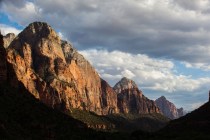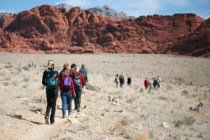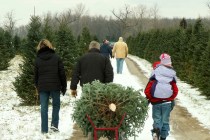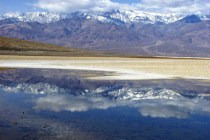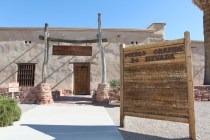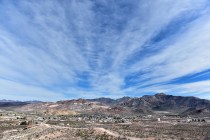Rock art, rock climbers inhabit Keyhole Canyon
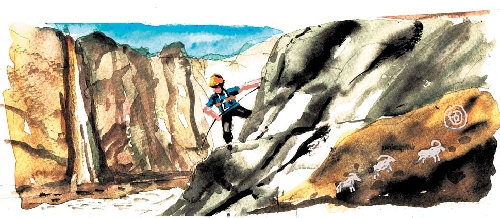
A steep-walled box canyon carved into the foothills of the Eldorado Mountains, Keyhole Canyon harbors ancient rock art and challenging rock climbing routes and is just a half-hour drive from Las Vegas. Lighter in color and shinier than other kinds of stone in these hills, the granite cliffs defining the entrance to the slot canyon are visible from U.S. Highway 95, the route south from Railroad Pass toward Searchlight and Laughlin.
Heading south on U.S. 95, use your odometer to mark 15 miles from the Railroad Pass junction. You will pass the turnoff to Nelson and Eldorado Canyon. Watch for an unmarked turnout in the divided highway about five miles south of that turnoff. Carefully crossing the northbound highway lanes, turn right onto a gravel road. Although not a bad road by desert dirt road standards, this isn’t one to navigate your low-slung sports car. You won’t need four-wheel drive, but vehicles with some ground clearance are advisable. There will be sandy spots and washboarded sections, so drive slowly and carefully. Count on a little dust.
Follow the gravel road from the highway 2.2 miles, passing beneath a set of power lines, where you will turn right again and head south. Drive 1.8 miles, a straight route south except where the road crosses a couple of major washes. Watch for the short Keyhole Canyon spur, which should be marked. Turn left to reach the rustic fence closing the canyon’s entrance to all but foot traffic.
The Bureau of Land Management created a parking area with enough cleared space to turn around. Some visitors enjoy tailgate picnics or find places to sit on boulders. A primitive privy at the edge of the cleared area is the only other development at the site. There is no water available, so bring enough for drinking and vehicle emergencies. Please take your refuse home for disposal.
Two parallel fence sections form a gateless entry to Keyhole Canyon, a means of protecting the recognized archaeological site from motorized approach. Follow the pathway to the canyon’s entrance.
A gravel-bottomed gorge extends several hundred feet back into the mountain, walled by steep rocky cliffs and tumbled boulders. At one point, visitors must slide carefully over a huge wedged boulder to reach the upper end of the canyon. The canyon ends where a dry waterfall drops from above. At the base of the waterfall, a rocky basin often holds runoff water for a few days after a rainstorm.
Time and eroding winds have worn away some of the petroglyphs left near the mouth of the blind canyon by native people centuries ago. Look for a few higher up on the boulders. Inside the canyon more rock art survives, both incised petroglyphs on rock faces and a few red ochre pictographs, usually found under rocky overhangs or on the bottom of rock slabs leaning on each other.
Recognizable symbols include stick figures of humans, likenesses of bighorn sheep and other desert creatures and many-rayed suns. Other more enigmatic symbols no doubt had meaning to the ancient visitors who left them but remain mysteries to modern observers. Take photos and admire the ancient handiwork, but resist touching the rock art or in any other way marring or defacing it. These remnants of past cultures are a heritage that belong to all of us and should be preserved for future generations.
Familiar with all the places where their unforgiving environment provided water, the ancient native people would have relied upon that intermittent resource in Keyhole Canyon. They might have even enhanced the rock basin at the base of the waterfall. Even without water, the canyon provided shade, cooler temperatures, shelter from wind and storms and a defensive position. Some of the blackening from fires against rock walls and under stone slabs in Keyhole Canyon might be from campfires where nomadic travelers gathered centuries ago.
Many rock climbers seek Keyhole Canyon for the challenges its granite surfaces and rock chimneys provide. A few rock anchors remain in place. Visitors untrained in this exacting sport should leave such climbing to those properly equipped and experienced in clinging to cliffs and climbing to dangerous heights.
Margo Bartlett Pesek’s Trip of the Week column appears on Sundays.





